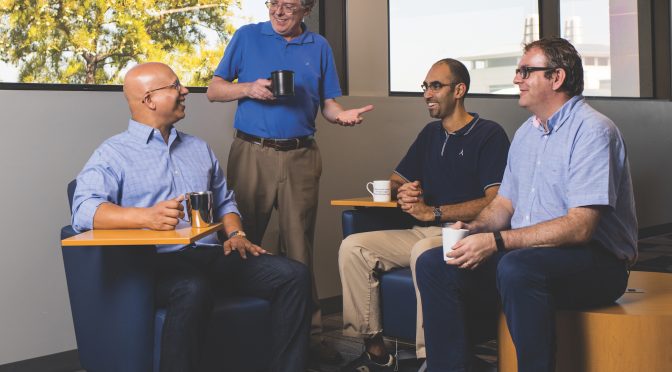We’ve all been there. Maybe you had a stressful day at work, drank too much coffee or watched one too many episodes on Netflix. You stayed up too late, and the next day, you’re paying for it.
You don’t need a scientist to tell you that sleep is crucial to overall health, but even in 2019, no one knows why, or even exactly how sleep is regulated. Those are questions Stephane Dissel, Ph.D., an assistant professor in the School of Biological and Chemical Sciences, is trying to answer.
“We still do not know why we sleep,” Dissel says. “We know it’s important, and we can describe sleep from a brain activity point of view, but what really is happening and why it’s important that we sleep is still a question. It’s still a mystery.”
It’s a mystery he’s not solving alone. Dissel is part of a team of faculty members in the School of Biological and Chemical Sciences with a unique collaborative relationship. Each member of the team is working on their own separate projects, but in each case, the research involves sleep.
Assistant professor Ryan Mohan, Ph.D., is studying neurodegeneration, which is clearly associated with lack of quality sleep, and associate professor Samuel Bouyain, D.Phil., is an expert in X-ray crystallography. It’s a technique he used to determine the structure of a protein dubbed “bride of double-time,” which is believed to play a role in the biological clock.
Professor Jeffrey Price, Ph.D., is another collaborator. He was an author on two of the seven key publications on circadian rhythms that led up to the 2017 Nobel Prize in Medicine. But since then, his focus has somewhat shifted.
“A lot of the circadian field has moved into sleep, actually, at least in the fly community,” Price says.
Yes, the fly community. That’s another way these scientists are linked. Fruit flies, the annoying insects you can’t keep away from your trash can, are an essential part of their research. In their labs, these faculty use state-of-the-art equipment that allows them to see stunning levels of detail, all the way down to the individual neurons in a living fruit fly’s brain.
“There are all sorts of similarities in the way sleep is regulated between humans and flies, so we’re using this model because it’s extremely valuable in terms of genetics,” Dissel says.
The setup is ideal. Each researcher is independent, but has a built-in support system of other scientists who are capable of having complex conversations about sleep homeostasis. They can also help troubleshoot when, for example, your fruit flies are “doing weird stuff,” as Dissel puts it.
It’s a group that took decades to assemble. Price was the first to arrive at UMKC in 1999, followed by Bouyain in 2006 and Mohan in 2015. Dissel is the newcomer, having only arrived in 2018. He says the opportunity for collaboration drew him to UMKC, after years doing sleep research with fruit flies at Washington University in St. Louis.
“The main factor was that there were already people using the fly as a model in this school,” Dissel explains. “I wanted to be in a place where I would not be isolated.”
Isolation is not an issue within this team. Not only are their research areas connected, so are their work areas.
“It’s not very hard to get in contact with them,” Price says, while gesturing toward the door to his office. “The Bouyain lab is right over here and I’m right down the hall, so we just bump into each other in the hallway. Stephane is on the hallway on the other side, and Ryan is right above me.”
They have meetings, but they’re not formal, or even scheduled. One topic that’s always of interest, besides fruit flies, is technology. The next time you complain about your iPhone being obsolete after just a few years, imagine what it’s like to keep track of technological advances that happen almost daily. That’s often the case for researchers who work with fruit flies.
“There will be new technology tomorrow that will give you the possibility of doing something you couldn’t do five years ago,” Dissel says. “Having more people in the department is a good thing, especially given the technology aspects of things. They may have heard something that I missed.”
As the scope of research continues to grow, so does the department. One recent addition is Jialin Wang, a visiting Ph.D. student from China Agricultural University who is hoping to shed more light on the link between Price’s and Dissel’s research. Wang is studying a gene called DBT, which she already knows has a role in circadian rhythm and suspects may also be involved in sleep.
“Dr. Price and Dr. Dissel are experts in these aspects,” Wang says, and they offer her knowledge, mentorship and facilities that brought her to UMKC from halfway around the world.
Price says he hopes the work he and his fellow faculty are doing attracts more researchers interested in sleep, circadian rhythms and fruit flies, from undergraduate students to experienced scientists who have already spent decades in the field.
“I’m hoping we can become a hub for basic genetic research,” Price says.



